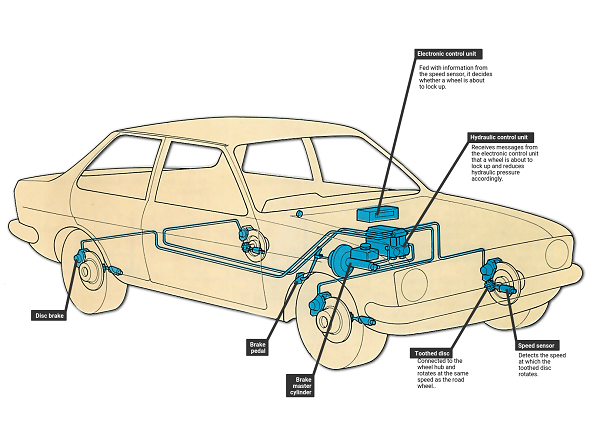Meaning of anti-lock braking system
The anti-lock braking system popularly known as ABS is one feature you will see in all modern vehicles. Despite this, many people still don’t know what it means and how it works in their cars. This obviously has nothing to do with your years of experience as a driver. Aside performance level, ABS says a lot about your safety on the road. Many at times, drivers are quick to hitting the brake when an obstacle appears on the road or while they are trying to prevent possible collision against what lies ahead.

The sole purpose of the anti-lock braking system is to prevent the locking up of wheels and keep their grips properly with the road surface. This system was originally introduced in the 50s as anti-skid system for airplanes. Chrysler and Ford however proved its usefulness on cars in the 70s.
Working principle of anti-lock braking system
The anti-lock braking system is a component of the electronic stability control, which ensures stability by monitoring the wheels during heavy braking. There is sensor attached to every wheel. The system will release the brake in a situation when there is detection by the sensors of a possible locking up of the wheels. This kind of release is mostly temporary and most applicable when the wheels stop moving.
The anti-brake locking system applies maximum braking pressure continuously to every wheel. By implication, braking will occur but not to the extent of locking the wheels. You will know whether the ABS is working or not whenever you press the brake pedal. When you feel pulsation or vibration via the pedal, it means the system is active.

The ABS ensures that the person behind the wheel has control of the car instead of bringing it to a stop. The ABS reduces the danger of skidding especially under extreme maneuvering. It’s important you remember that the braking distance of your car will increase under such circumstance. When you continue to drive right into an obstacle, the vehicle may not come to a halt in time even when your intuition says otherwise. This is why it’s a myth when people think that the ABS reduces stopping distance. The design of the ABS is to help maintain ability to steer while preventing skidding.
Effectiveness of the anti-lock braking system
While some people do not feel the need for ABS in their car, it is important to note that this braking system will guarantee your safety on the road. The possibility of Cars fitted with anti-lock braking system to be involved in road accident is less compared to those without. In most cases, this system helps to reduce the chance of frontal collision on dry and wet roads. Another reason why you need the ABS is that it prevents your car from straying especially from road ahead. Ideally, the ABS is most suitable for solid and stable road surface.
How to simulate ABS technique on cars without anti-lock braking system
Since we know that older cars might not have the ABS or even when the system fails to work, there is always a way out for drivers. What you should in such situation is to repeatedly apply and release the brake. Although, the rate at which you brake may not be as fast as the ABS but it will keep you in control for the time being.
>>> For more informative auto news and car tips like this, click here!
